Articles
| Name | Author | |
|---|---|---|
| Case Study: The Fuel Saving program and initiatives at Air Transat | Gabriel M. Blanchette, Flight Operations Engineering Specialist, Air Transat | View article |
| Case Study: WestJet Encore’s Connected Aircraft Tablet EFB Project | Capt. David Hathaway, Pilot, WestJet Encore, Greg Mardon, Systems Analyst / Software Engineer, WestJet and Bernard Asare, VP — Data Analytics, Global Eagle Entertainment | View article |
| Case Study: New Methods to Manage Digital Information | Alex Skrabal, Manager eOperations, SWISS International Airlines (SWISS) | View article |
| Connectivity in the Flight Deck | Jeffrey E. Rex, Director Engineering & Business Development, Panasonic | View article |
Case Study: WestJet Encore’s Connected Aircraft Tablet EFB Project
Author: Capt. David Hathaway, Pilot, WestJet Encore, Greg Mardon, Systems Analyst / Software Engineer, WestJet and Bernard Asare, VP — Data Analytics, Global Eagle Entertainment
Subscribe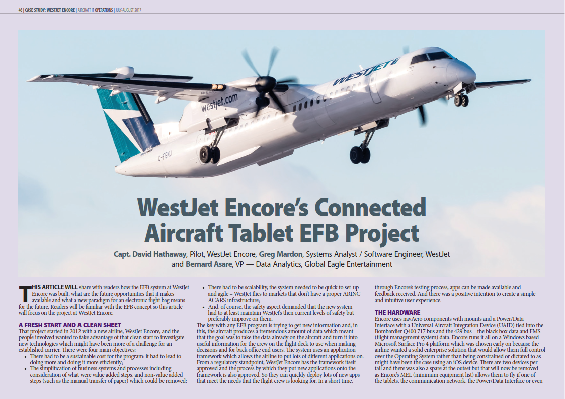
WestJet Encore’s Connected Aircraft Tablet EFB Project
This article will share with readers how the EFB system at WestJet Encore was built, what are the future opportunities that it makes available and what a new paradigm for an electronic flight bag means for the future. Readers will be familiar with the EFB concept so this article will focus on the project at WestJet Encore.
A FRESH START AND A CLEAN SHEET
That project started in 2012 with a new airline, WestJet Encore, and the people involved wanted to take advantage of that clean start to investigate new technologies which might have been more of a challenge for an established carrier. There were four main objectives:
- There had to be a sustainable cost for the program: it had to lead to doing more and doing it more efficiently;
- The simplification of business systems and processes including consideration of what were value added steps, and non-value added steps (such as the manual transfer of paper) which could be removed;
- There had to be scalability, the system needed to be quick to set-up and agile – WestJet flies to markets that don’t have a proper ARINC ACARS infrastructure;
- And, of course, the safety aspect demanded that the new system had to at least maintain WestJet’s then current levels of safety but preferably improve on them.
The key with any EFB program is trying to get new information and, in this, the aircraft produces a tremendous amount of data which meant that the goal was to take the data already on the aircraft and turn it into useful information for the crew on the flight deck to use when making decisions and for back office end users. The system uses an application framework which allows the airline to put lots of different applications on. From a regulatory standpoint, WestJet Encore has the framework itself approved and the process by which they put new applications onto the framework is also approved. So they can quickly deploy lots of new apps that meet the needs that the flight crew is looking for. In a short time, through Encore’s testing process, apps can be made available and feedback received. And there was a positive intention to create a simple and intuitive user experience.
THE HARDWARE
Encore uses navAero components with mounts and a Power/Data Interface with a Universal Aircraft Integration Device (UAID) tied into the Bombardier Q400 717 bus and the 429 bus – the black box data and FMS (flight management system) data. Encore runs it all on a Windows based Microsoft Surface Pro 4 platform which was chosen early on because the airline wanted a solid enterprise solution that would allow them full control over the Operating System rather than being constrained or dictated to as might have been the case using an iOS device. There are two devices per tail and there was also a spare at the outset but that will now be removed as Encore’s MEL (minimum equipment list) allows them to fly if one of the tablets, the communication network, the Power/Data Interface or even the cables fail: they can go up to four legs without having to replace any of those failures until a maintenance base is reached where the device can be repaired. The system is also integrated to the discretes on the aircraft, pulling in sensor information that wasn’t previously available such as weight-on-wheels sensors, engine oil pressure and door sensors.
Encore uses LTE modems plugged into a USB port which offers more flexibility including being able to run multiple SIM cards so that when an aircraft flies to different areas with different requirements, the system can switch, if need be.
THE SYSTEM
Making best use of the capability
The whole program is self-hosted with most of WestJet’s servers on-site. Figure 1 shows a snapshot of just some of the applications available to crew when ICAS (Integrated Communication and Application System) was released…

Figure 1
… which shows that it’s possible to do more than just a moving map with a lot more capability for the pilots. In fact ICAS is now installed during production by Bombardier for WestJet Encore aircraft.
The apps
Looking more closely at a couple of the apps…
ACMS – Aircraft Condition Monitoring System
The Q400 doesn’t come with an ACMS solution from the factory so instead of buying a system at some $20,000-30,000 a tail, Encore knew that it had the data so opted to do this for itself, monitoring four conditions:
- Hard landing;
- Vmo;
- Vfe;
- Severe turbulence.
When one of these events happens, the aircraft will send an alert to maintenance and will show the pilot what has happened. Figure 2 shows how a hard landing alert looks…
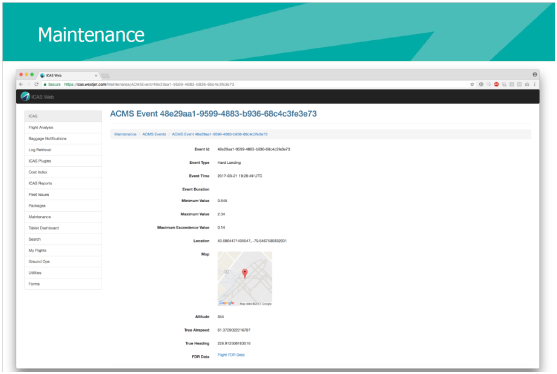
Figure 2
… and figure 3 shows the FDR data in graph form; hugely valuable for the engineer. This was always existent but he engineers used to have to plug in to the FDR on the plane, download the data, send it to Bombardier (for a fee of c$3,000) and wait four hours to get the data back in a usable form.
Now, the system gets the information as the plane comes into gate and the information can be seen by maintenance people on their mobile phone and by MCC (Maintenance Control Center) at the office It replicates a traditional ACMS solution but for a fraction of the cost and offers feedback, in this case of a hard landing, whether it really was a hard landing and allows work to be completed more swiftly. The same would apply for the other conditions monitored.
Weight and Balance
Another example of how data is used is in presenting new information to pilots. Figure 3 is a screen shot of the weight and balance system…

Figure 3
… the log book application with Weight & Balance inside it. Encore uses Aerodata so the data is returned from Phoenix to be displayed. Among the items on this screen is a flap warning to alert the pilot if his flaps are set incorrectly. Encore instigated this following an incident where an aircraft took off with the wrong flap setting so this app now shows a warning until the flaps are set correctly. It’s a good example of having two pieces of useful information (weight and balance and the aircraft condition) which, when combined, create a new piece of useful information.
Turbulence
Another example is the capture of accelerometer data throughout the flight (figure 4) on all of Encore’s aircraft.
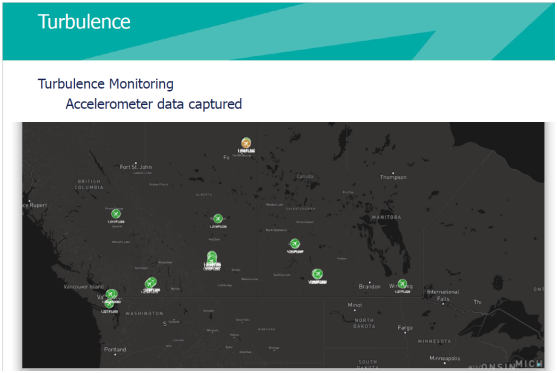
Figure 4
Figure 4 shows a map that’s made available for pilots and dispatchers and anyone else in the organization who can use it that shows incidence of ‘light’, ‘moderate’ and ‘severe’ turbulence. The G-forces are captured and transmitted to the ground to all other aircraft on the ground or to aircraft in the air over ACARS and to dispatchers. So if the airline can see that over a particular place it’s going to be bumpy it’s possible for pilots to have their passengers buckle up a bit earlier than just before landing. Also, the system can use machine learning and forecast data to determine, where there was turbulence, what the accompanying wind, temperature and environmental factors. This helps in predicting the likelihood and potential location of future turbulence events in the next couple of hours.
ATLAS
A recent development in this has been a flight watch tool that WestJet Encore has called Atlas (figure 5).

Figure 5
It displays the data in the system in one view. Encore was flying into places with no ACARS coverage, so the airline had no idea whether the plane had actually landed. But there were the tablets and there is 3G (or LTE) everywhere that Encore aircraft land and so the airline can see aircraft positions from the tablets all in one view. ATLAS is connected to weight and balance information, to cargo information… and it’s all displayed in one view for the dispatchers (figure 6 on the right).
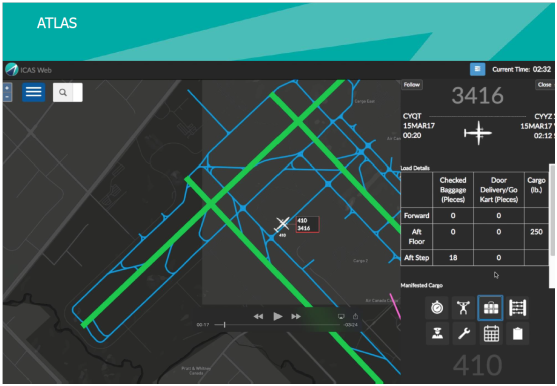
Figure 6
It’s also connected to crew information which is displayed for the dispatchers as well as maintenance information, i.e. are there any defects? Everything on the system was already available for the pilots and is now available for the dispatchers with the exact same view. Atlas delivers one holistic view so that users don’t need to plough through a lot of different applications. The system allows users to search for things such as airports, flight numbers, whatever they need.
PREDICTIVE TECHNOLOGY
Encore also uses machine learning to predict taxi times; taking historical taxi time information and information about other factors at the time such as temperature at that time of day, that time of year, and traffic levels, to predict at every airport at different times and in various conditions, how long taxiing should take. It also shows weather stats, known fronts, radar feeds, significant weather, lightning and environmental information from satellites (GOES). Again, it’s all on the pilots’ tablets (figure 7) through ICAS so the same view is delivered to dispatchers.
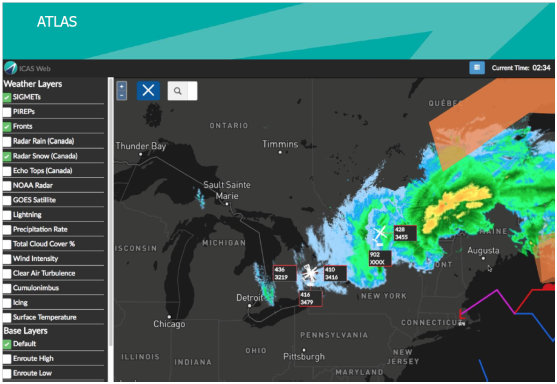
Figure 7
With the connection to forecast data, it’s possible for the weather timeline to be projected into the future and as the airline knows where its aircraft are going to be at any given time, that information can be trended out to see what weather they’re likely to encounter. Plus, it’s integrated with SkyVector flight planning support. All the above has been live since mid-January 2017 and even though, for dispatchers, it was still at Beta stage at the time of writing, they started using it right away because of the information it offers.
The system is now being connected with SWIM (system-wide information management) data for surface movements at 35 airports in the US as well as air movements where it has coverage. Another addition to the system is cost indexing. Everyone does cost indexing but the difference with WestJet Encore is they use real aircraft data in real time to optimize the best true airspeed and fuel flow.
ATLAS has been running for half a year at the time of writing and the airline has already seen fuel savings of $8,000 with just ten pilots testing it. Projected out to the whole pilot community, the expectation is in the region of $1.4m savings in a calendar year based on the number of flights that will use it. Individual savings of $30-50 per flight don’t sound much but with 150 flights a day already and plans to increase that to 200 flights a day by the end of 2017, readers will appreciate how quickly the savings can accumulate.
MACHINE LEARNING
The next focus will be on machine learning with turn analysis and management, and predicted taxi times. Encore is also using machine learning to calculate cost index tables; Bombardier supplies tables which are OK but Encore can build cost index tables per aircraft because a lot of historic fuel burn information is available that can be used to generate tables. Also, because the Q400 aircraft is very susceptible to weight and balance issues, the airline can give the crew the information they need to make decisions about what or who to remove in the event that the aircraft is overweight and that information can be made available at the beginning of the workflow rather than at the end of the workflow when they’re ready to go.
HOW THIS WAS ACHIEVED
Of course, all of this is very well, but the big question in readers’ minds will be, how was it done? A project like this requires vision and a perspective of ‘how do we explore the data and make it more useful?’ One of the main things that the project team wanted to address was integration. There are a lot of inputs to the system and, if integration doesn’t happen, the result is a ‘spaghetti mix’ of getting different systems to talk with each other with different transfer mechanisms, different protocols and more. That was a real challenge and the team had to identify the key people in various departments as well as deal with the political challenges that exist in any organization with silos that have to be broken down.
Also, before going live, the team needed a safe place to fail which was really important because if the team doesn’t feel they can explore the boundaries and edges of what they wish to do without risking some sort of severe consequence it makes it difficult to stretch the vision and move forward. Similarly, it’s important to have a champion for innovation.
The advantage for people at Encore was that it was brand new, a clean sheet and so they were able to think, from the outset, how things could be different from what goes on the legacy airlines. The pilots and flight attendants would never know anything different from what Encore was so change management did not need to be considered. It was also valuable to have executive backing for the program. But the vision was the most important, being able to identify that there was so much data coming off the aircraft and, with new aircraft coming this year, like the 737 MAX, there will be even more data coming in. the challenge was what could be done with that data, how could it be leveraged to be valuable?
Start small
The key is to start with a small objective, just win some success in a single area. In this case, the team started with the electronic flight folder, trying to get a flight plan and then, when that was successful, moved on to think what else they might do. Creating stakeholders with pilots and flight attendants was the most effective opportunity because they would say exactly what they wanted. And, because of the application framework mentioned right at the start of this article, it was quick to build solutions, launch them out to the Cloud and get them onto the devices for immediate feedback on how the system was working.
The team was actually about the equivalent of 1.8 full time employees working over 18 months from conception to getting it coded and out to the aircraft. The Atlas component started in January 2017 and, using feedback from crews, is subject to continuous improvement and new opportunities to provide more feeds to users.
THE WAY AHEAD
Across the WestJet group they’re deploying features of the Encore system on some 737 aircraft although they have a different architecture with pilot-issued iPads currently and Astronics webFB. So the plan is to harness data using the EFB that are already available with a view to a future installation of the new system in full once the iPads become obsolete.
Figure 8 shows what is planned for the future.
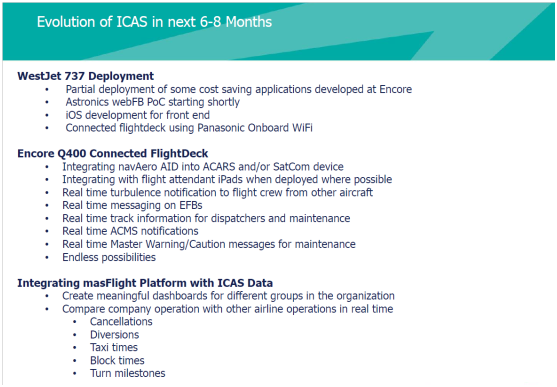
Figure 8
The whole development will be built around integration and communication so that all the data goes into a data warehouse from where it can be deployed in various functions to add real value to the information delivered to users using analytics that make it possible to answer questions that couldn’t even be asked before.
INTEGRATING WITH THE WIDER WORLD
So far, this article has addressed integrated applications in the cockpit that also integrate with the dispatch function on the ground; it’s addressed connectivity in real-time and less than real time and getting data off the aircraft down to the ground. All of the information mentioned is for WestJet Encore giving them full situational awareness of what they do with which to manage their operations. But, of course, theirs’ aren’t the only aircraft in the air; they fly among other airlines so they also need information on what other airlines are doing at the airports to which Encore operates. And this is where masFlight comes in to play.
Over the past seven or eight years, Global Eagle has built a platform that can aggregate information on anything that has to do with flights… schedules, flight status, UI (user interface) data, flight plan data, tracking data, AODB (Air Operations Database) derived data across the airline sector. It’s all set out in figure 9.
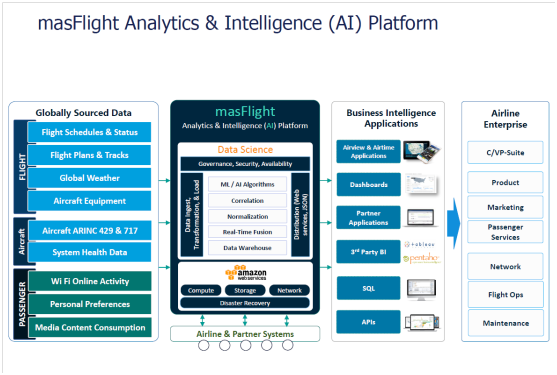
Figure 9
Everything is integrated in one data warehouse hosted on the Amazon Cloud. The data collected offers an understanding of global airline schedules with Global Eagle monitoring some 80,000 to 90,000 flights every day and storing UI data on every flight. Data scientists, who are both experts with the technology and systems but also understand flight operations, validate and verify, normalize and store the data for operational use. The reason this is important is that users need to have full trust in any data they receive, even when it has been initiated outside of their own information environment; they need to be receiving the data from a trusted source that has gone through the steps above before posting the data for others to use.
The platform can be accessed through APIs (Application Programming Interfaces) or through third party, off-the-shelf BI (Business Intelligence) applications, using sequenced access and through APIs. Global Eagle’s work with WestJet is to provide full situational awareness of operations at the airports to which they fly and on routes that they fly, etc.
THE CONNECTED AIRPLANE
The vision is to deliver the fully connected airplane (figure 10).

Figure 10
A lot of people talk about connected airplanes, real-time data streaming and so on but what really matters is understanding that a different workflow in an airline enables a lot of benefits; and that integrated applications providing situational awareness in the cockpit, the dispatch and executive suites on the front line are what makes an airline tick. The other component is the platform on the ground that allows users to analyze the data; aircraft don’t have enough processing power to exploit all of the data they generate. Clouds such as the Amazon Cloud, the Azure Cloud have immense processing power to deliver all the functions covered in this article. The connected airplane is being delivered through integrated applications, connectivity to the airplane, massive ground processing power and easy access to the data to enable different workflows across the airline.
Contributor’s Details
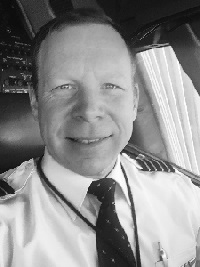 Capt. David Hathaway
Capt. David HathawayDavid’s focus in recent years with WestJet Encore has been exploring and discovering the full potential of personal electronic devices both in the flight deck and in the cabin. He has also been involved developing and implementing WestJet’s RNP program. He is currently a line pilot on 737 for WestJet in Calgary, plus provides Flight Technical Support (specifically EFB development) for WestJet Encore.
 Greg Mardon
Greg MardonGraduating from the University of Calgary in 2013 majoring in Computer Science, Greg started working as a contractor in IT, helping architect and deploy Microsoft solutions for organizations. He joined WestJet in late 2013, helping them with managing and imaging their EFB tablets. Soon after, Greg started developing tools and utilities for WestJet and WestJet Encore for flight operations and other groups. He is also a certified Cloud Solutions Architect for Microsoft Azure.
 Bernard Asare
Bernard AsareBernard Asare is Vice President of Data Analytics at Global Eagle Inc. leading the Data Analytics Business Unit which delivers high-impact insights to airlines via a set of applications, analytic services, and APIs on the masFlight Analytics & Intelligence (AI) platform. Bernard holds Bachelor’s and Master’s degrees in Aeronautical and Astronautical Engineering from the Massachusetts Institute of Technology (MIT) and resides in Washington, D.C.
 West Jet Encore
West Jet EncoreWestJet Encore is the regional subsidiary of Canada’s WestJet and operates the Bombardier Q400. The Calgary based airline commenced operations on June 24, 2013, using a fleet of 2 Bombardier Q400s with options for up to 45 by the end of 2018. At the time of writing the fleet had grown to 38 aircraft (all Dash 8 Q400) with a further seven to be delivered.
 Global Eagle Entertainment (GEE)
Global Eagle Entertainment (GEE)Global Eagle Entertainment Inc. is a worldwide provider of aircraft connectivity systems, operations solutions and media content to the travel industry, providing airlines with a wide range of in-flight solutions. These include Wi-Fi, movies, television, music, interactive software, as well as portable IFE solutions, content management services, e-commerce solutions and original content development, serving more than 200 airlines worldwide.
Comments (0)
There are currently no comments about this article.

To post a comment, please login or subscribe.